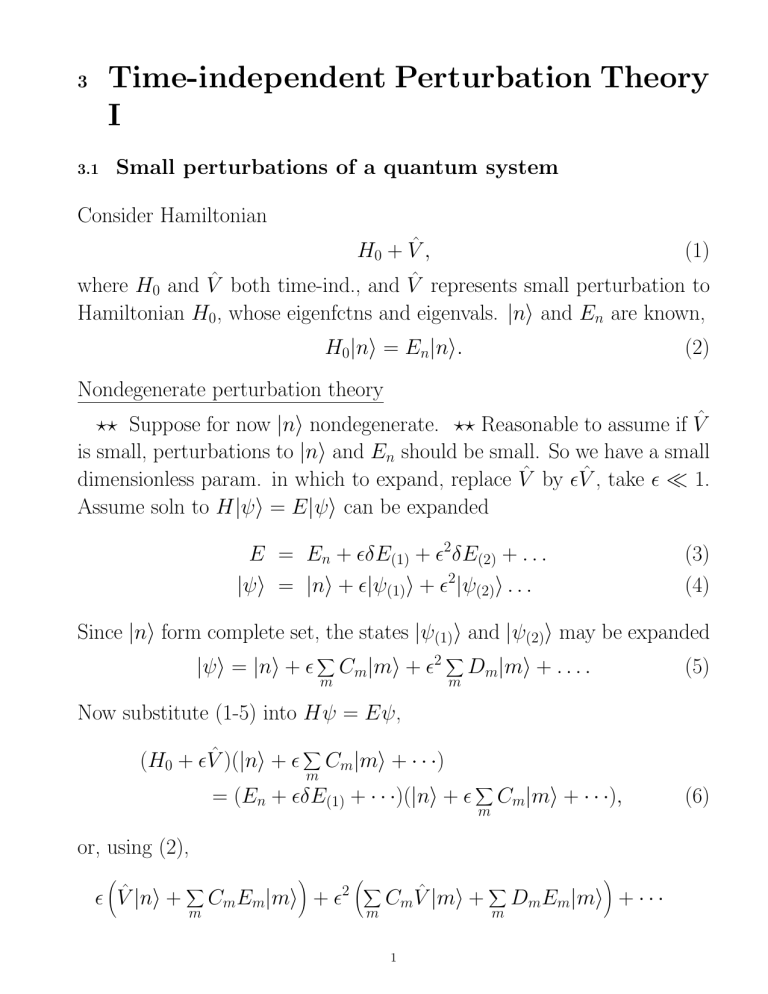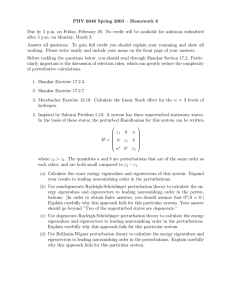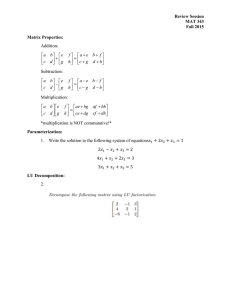Time-independent Perturbation Theory I
advertisement

Time-independent Perturbation Theory
I
3
3.1
Small perturbations of a quantum system
Consider Hamiltonian
H0 + V̂ ,
(1)
where H0 and V̂ both time-ind., and V̂ represents small perturbation to
Hamiltonian H0, whose eigenfctns and eigenvals. |ni and En are known,
H0|ni = En|ni.
(2)
Nondegenerate perturbation theory
?? Suppose for now |ni nondegenerate. ?? Reasonable to assume if V̂
is small, perturbations to |ni and En should be small. So we have a small
dimensionless param. in which to expand, replace V̂ by ²V̂ , take ² ¿ 1.
Assume soln to H|ψi = E|ψi can be expanded
E = En + ²δE(1) + ²2δE(2) + . . .
|ψi = |ni + ²|ψ(1)i + ²2|ψ(2)i . . .
(3)
(4)
Since |ni form complete set, the states |ψ(1)i and |ψ(2)i may be expanded
|ψi = |ni + ²
X
m
Cm|mi + ²2
X
m
Dm|mi + . . . .
(5)
Now substitute (1-5) into Hψ = Eψ,
(H0 + ²V̂ )(|ni + ²
X
m
Cm|mi + · · ·)
= (En + ²δE(1) + · · ·)(|ni + ²
X
m
Cm|mi + · · ·),
or, using (2),
Ã
² V̂ |ni +
X
m
!
CmEm|mi +
Ã
X
²2
CmV̂
m
1
|mi +
X
m
!
DmEm|mi + · · ·
(6)
Ã
= ² δE(1)|ni + En
Ã
X
m
!
Cm|mi
+²2 δE(2)|ni + δE(1)
X
m
(7)
Cm|mi + En
X
m
!
Dm|mi .
Now equate powers of ² to find (O(1)):
V̂ |ni +
X
m
CmEm|mi = δE(1)|ni + En
X
Cm|mi.
m
(8)
Now take inner product with hn|, use hn|mi = δnm:
δE(1) = hn|V̂ |ni
(9)
so 1st-order shift in energy level for state |ni is just expectation value of
V̂ in that state. Now take inner product with hm|, find
Cm =
hm|V̂ |ni
, m 6= n
En − Em
so energy eigenstate is, to 1st order,
|ψi = |ni + ²
Cn |ni +
(10)
|mihm|V̂ |ni
+ O(²2 ).
m6=n En − Em
X
(11)
What is the coefficient Cn? Actually we can’t determine it! Note we could
write instead of (9),
|ψi = (1 + ²Cn)
|ni + ²
|mihm|V̂ |ni
+ O(²2 )
m6=n En − Em
X
(12)
the same up to corrections of O(²2). Here see that Cn just is part of overall
normalization factor; can’t determine since S.-eqn. is linear. Same applies
to Dn, etc. Go back and expand to 2nd order, using (9) and (10). Find:
δE(2) =
hn|V̂ |mihm|V̂ |ni
, so
E
−
E
m6=n
n
m
X
E = En + ²hn|V̂ |ni + ²2
P
m6=n
hn|V̂ |mihm|V̂ |ni
+ O(²3)
En − Em
2
(13)
(14)
Note when we actually do calculations we will set ² = 1 at end—we just
put it in to help classify the terms in powers of V̂ formally!
3.2
DC Stark effect
(Shift of energy levels of atom placed in static homogeneous electric field).
Consider atom in constant E field. Potential energy of each charge in
atom just work done to move charge from origin in presence of field. So
V̂ = −E ·
X
i
qiri
= −E · d
(15)
(16)
where qi is charge on ith particle, ri is position of ith particle in atom,
and d is the dipole moment operator.
? Temporarily let’s write energies as E to avoid confusion with E-field.
Continue to assume eigenstates of H0 nondegenerate—first order energy
shift (from (9)):
X
δE(1) = −E · qihn|ri|ni = 0
(17)
i
R
That this vanishes follows from hn|ri|ni = d3riri|ψn(ri)|2 = 0, since |ni
are eigenstates of parity Π̂, but r is odd under parity. So we have to go to
2nd order (Eq. (14):
hn|V̂ |mihm|V̂ |ni
En − Em
m6=n
X
X hn|dα |mihm|dβ |ni
=
Eα Eβ
En − Em
αβ
m6=n
1 X αβ
α Eα Eβ
≡ −
2 αβ
δE(2) =
X
(18)
(19)
(20)
where we made analogy with classical E & M in last step above—ααβ is
polarizability tensor. For atom without permanent dipole moment, d
3
itself ∝ applied field E, d = αE. Work done on atomic “springs” by
E-field is
δW =
X
i
qiE · δri = E · δd =
X
αβ
Eα ααβ δEβ
(21)
So total work involved in increasing field from 0 to E is
W =
Z X
αβ
=
Eα ααβ δEβ
1 X αβ
α Eα Eβ
2 αβ
(22)
(23)
This is work stored in atomic “springs”, but we must add to this the
decrease in system’s energy due to changed positions of particles in E:
U = −E · d = −
X
αβ
ααβ Eβ Eα
(24)
Total energy shift must be negative:
1
(25)
δE = W + U = − ααβ Eα Eβ
2
so our quantum result (20) actually in accord with classical intuition here,
as it should be since we are treating E-field classically. Check to make sure
you see why α defined in (20) is always positive if n = 0, ground state!
Note to get final answer to (2) need to know matrix elements of dipole
operator, can calculate later.
3.3
Degenerate perturbation theory
Note that we start with a state labelled by |ni and perturb around it.
Energy shift (18) well-defined if states nondegenerate, but what if there is
an |mi for which En = Em in (18). Theory breaks down. Need to go back
and redo things for the degenerate case. Call e’states of H |n, αi where n
labels energy level and α labels different energy e’states with same energy
e’value,
4
H0|n, αi = En|n, αi
hn, α|m, βi = δmnδαβ .
(26)
(27)
Let’s again expand energy and wave fctn.,
E = En + δE(1) + δE(2)
X
|ψi = |n, αi + Cmβ |m, βi + · · ·
(28)
(29)
mβ
where I supressed the ²’s for compactness. Completeness says
V̂ |n, αi =
X
|m, βihm, β|V̂ |n, αi,
(30)
m,β
so generalization of (7) to O(²) is
V̂ |n, αi +
X
m,β
=
X
m,β
Cmβ Em|m, βi
µ
|m, βi hm, β|V̂ |n, αi + Cmβ Em
= δE(1)|n, αi + En
X
mβ
¶
Cmβ |m, βi.
(31)
Coefficicent of |m, βi on both sides of (31) must agree, so
hm, β|V̂ |n, αi + Cmβ Em = EnCmβ + δE(1)δnmδαβ .
(32)
Two cases again:
m 6= n
Cmβ =
hmβ|V̂ |nαi
En − Em
(33)
m=n
δE(1)δαβ = hnβ|V̂ |nαi
(34)
If hnβ|V̂ |nαi = 0 when α 6= β, the equation (34) makes sense, and we
get
δE(1) = hnα|V̂ |nαi
5
(35)
Note this means possibly a different splitting for each of the initially degenerate states |nαi, but is otherwise more or less same as nondegenerate
case. But if hnβ|V̂ |nαi 6= 0 when α 6= β, Eq. (34) doesn’t have a
solution, we get some kind of contradiction. What’s going on?
?? Recall what we said about eigenvectors corresponding to distinct eigenvalues being orthogonal. If eigenvalues are degenerate, various eigenvectors
need not be orthogonal—however if they aren’t, we can construct a new
set corresponding to same e’value which are! ??.
Can pull similar trick here: construct N linearly independent combinations (N is the degeneracy of En, e’value in question) of form
P
|Ai = α Aα |nαi
P
|Bi = α Bα |nαi
N eigenstates
P
|Ci
=
α Cα |nαi
...
(36)
Now choose {Aα , Bα , . . .} such that
hA|V̂ |Bi = 0, etc.
(37)
Redo previous calc. leading to (32), find now no inconsistency, rather
δE(1) = hA|V̂ |Ai
if |Ai is unperturbed state,
= hB|V̂ |Bi
...
if |Bi is unperturbed state,
(38)
If (37) holds, means V̂ is diagonal on subspace of degenerate eigenvectors,
so can write V̂ |Ai = VA|Ai, etc. In terms of the original basis this is
X
α
Aα V̂ |n, αi = VA
X
α
Aα |n, αi,
(39)
and inner product with hn, β| is
X
α
hn, β|V̂ |n, αiAα = VAAβ ,
or, in suggestive matrix form,
6
(40)
~ = VAA,
~ etc.
V A
(41)
So we have reduced the degenerate state perturbation problem to the
problem of diagonalizing V̂ and finding its eigenvalues and eigenvectors.
Once found, the N eigenvalues VA, VB , etc. give the energy perturbations,
E = En + VA, En + VB , . . ..
Summary
I know this is confusing. Here’s what you have to do in practice. If
you have N degenerate states |αi corresponding to one eigenvalue E,
construct the matrix hα|V |α0i. If it happens to be diagonal, you’ve got
it easy: for each α, read off the 1st order energy shifts, δEα = hα|V |αi.
The wave function will have no 1st order shift arising from the hα|V |α0i,
but beware it can still have corrections coming from the hα|V |mi, where
the |mi are the states outside the degenerate manifold you’re looking at.
If hα|V |α0i isn’t diagonal, you need to find a new basis |α0i in which it is,
i.e. diagonalize it! You get eigenvalues VA, VB , ... (the new energy shifts)
and eigenvectors |Ai, |Bi..., which are linear combinations of the old |αi.
If you calculate the 1st order correction to the wavefunction with the new
basis, the terms containing hA|V |Bi will again vanish for A 6= B, but
don’t forget you will still have terms like hm|V |Ai which are nonzero.
Linear Stark effect
Note for nondegenerate case 1st order Stark shift vanished, i.e. δE ∼ E 2.
If two or more atomic states degenerate, need to go back & compute matrix
elements
hn, α|V̂ |n, βi
(42)
and diagonalize. While diagonal elements in original basis will still vanish
due to parity (recall V̂ ∝ Er), off-diagonal ones needn’t. Thus when V̂ is
nondiagonal there will in general be linear shift ∝ E. Linear dependence
on applied field therefore =⇒ degenerate states. Equivalent in classical
case to atom with permanent dipole moment, i.e. in a field dipole moment
7
has a zeroth-order piece: d = d(E = 0)+δd(E). Energy E ' −d·E ∝ E
unlike (23).
Hydrogen atom n=2 states
Take B k ẑ, so V̂ = −Eez. 4 degenerate n = 2 states of H:
ψ200
ψ21m
r −r/2a0
1 −
2
=
e
Y00
3/2
2a
0
2a0
1 1 r −r/2a0
√
=
e
Y1m, m = 1, 0, −1
3/2
a
3 0
2a0
1
(43)
(44)
Note
1. ` = 0 state has even parity, ` = 1 states odd parity, whereas V̂ has
odd parity, so only states with different ` couple (only h200|V̂ |21mi
and h21m|V̂ |200i are nonzero in degenerate subspace).
2. V̂ commutes with L̂z , so only connects states with same m value!
Therefore only h200|V̂ |210i is nonvanishing.
Therefore matrix V in original basis is just 2 × 2:
h200|z|200i = 0 h200|z|210i
V =
h210|z|200i h210|z|210i = 0
(45)
Calculate:
r
2r
h200|V̂ |210i = 0 r2dr(2a0)−3e−r/a0 √
1−
r
2a
3a
0
0
Z
∗
× dΩ Y00 cos θY10
= −3a0
Z ∞
(46)
Now find eigenvalues δE(1)(i.e., diagonalize):
−δE(1) −3eEa0
= 0
det
−3eEa0 −δE(1)
8
(47)
Figure 1: Stark splittings of hydrogenic energy levels.
or δE(1) =
±3eEa
0 . Eigenvectors in subspace are (note (45) is propor
0 1
.)
tional to
1 0
1
1 1
|ψ1i = √ ≡ √ (|200i − |210i)
2 1
2
and
1 1
1
≡ √ (|200i + |210i)
|ψ2i = √
2 −1
2
(48)
Note
1. that the new states are not eigenstates of L̂2, since L̂2 doesn’t commute
with H.
2. that for the case of degenerate states Stark splitting linear in E-field!
9










